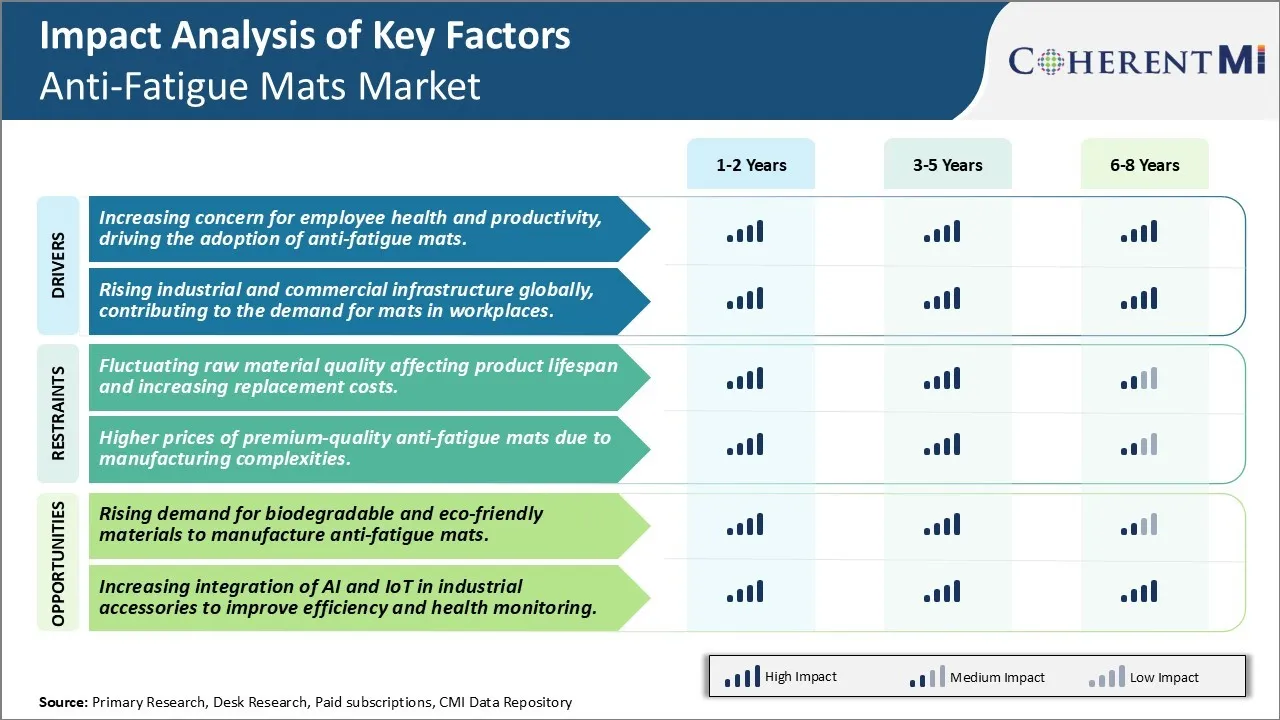Anti-Fatigue Mats Market Trends
Market Driver - Increasing Concern for Employee Health and Productivity, Driving the Adoption of Anti-fatigue Mats
Many organizations are realizing the importance of employee health, safety and well-being in the workplace. Prolonged periods of standing without any support can cause strains and fatigue to the feet, leg muscles and back. This affects the productivity of workers and increases absenteeism due to health issues. As per studies, proper ergonomics at the workplace can help reduce costs associated with injuries, workers compensation and lost productivity.
More employers are acknowledging that investing in better working conditions through the use of ergonomic equipment such as anti-fatigue mats can boost performance and reduce health risks for employees who are required to stand for long hours. Anti-fatigue mats provide cushioning and shock absorption which eases pressure on the feet, legs and spine. Workers feel less tiredness even after long shifts which translates to better focus and efficiency in work. Many employees also appreciate employers who demonstrate care for their wellbeing through provision of such supportive tools. This has resulted in improved employee loyalty and engagement levels.
With growing health concerns and work stress in today's fast-paced environment, companies realize the need to prioritize workers comfort and safety. Government regulations in some countries also mandate facilities to ensure ergonomic compliance at workplaces. Proactive employers conducted internal analyses which highlighted significant cost benefits realized through lower healthcare and compensation costs versus the affordable investment needed for anti-fatigue floor mats. Rising health insurance premiums provide further impetus to implement solutions for preventing work-related illnesses or injuries. The economic and social advantages of a healthier workforce have prompted varied industries to adopt anti-fatigue mats.
Market Driver - Rising Industrial and Commercial Infrastructure Globally, Contributing to the Demand for Mats in Workplaces
Worldwide, industrial and commercial construction has grown steadily with expanding urbanization and a thriving global economy in previous decades. Many developing nations are witnessing rapid industrialization with new manufacturing plants, warehouses and logistics centers coming up frequently. Meanwhile, developed markets continue to see business expansion and refurbishment of existing infrastructure. The diverse range of industries which stand to benefit from anti-fatigue mats include automotive, electronics, FMCG, healthcare, shipping, airports and more.
The increase in factory and facility sizes inherently leads to a rise in the number of employees who spend long duty hours on their feet. Further, greenfield projects and brownfield facility extensions involve prolonged physical work for construction workers too. With growing awareness of occupational health hazards, such projects are integrating ergonomic considerations from the start. This stimulates incorporation of anti-fatigue flooring like interlocking foam mats or rubber grid mats throughout the work areas and assembly lines.
Rising incomes globally have also expanded markets for diverse products and services. To match this, companies are constantly scaling up operations which demands a larger industrial labor force. In turn, this strengthens the business case for anti-fatigue mats to enhance worker comfort and retention across newer factories, distribution centers and construction sites worldwide. Overall, the proliferating commercial and industrial infrastructure has broadened the addressable areas where mats can make workplaces more conducive while upholding labor welfare standards. This represents a sustained tailwind for the anti-fatigue mat industry over the long term.

Market Challenge - Fluctuating Raw Material Quality Affecting Product Lifespan and Increasing Replacement Costs.
The quality of raw materials used in manufacturing anti-fatigue mats plays a crucial role in determining the longevity and performance of the final product. However, obtaining consistent high quality of inputs has been a challenge for mat manufacturers due to price fluctuations in the commodities market. Common raw materials used include rubber, plastics and textiles which are highly susceptible to supply bottlenecks and quality issues arising from geopolitical events or economic uncertainties. This leads to unpredictable variations in material characteristics batch-to-batch. Lower quality raw materials have significantly shorter lifespan when used as mats in workplaces that involve long hours of standing. They wear out and lose effectiveness quicker than expected, necessitating premature replacement. The associated extra costs dent user experience and manufacturers' profit margins. Frequent repurchases are also not economically viable for customers. Maintaining a stable supply of high performing inputs at optimal costs remains a key hurdle for the mat industry.
Market Opportunity - Rising Demand for Biodegradable and Eco-Friendly Materials to Manufacture Anti-Fatigue Mats.
With growing awareness about environmental sustainability, there is increasing consumer preference for green products across sectors. The anti-fatigue mat market is no exception to this global trend. Users and corporate buyers are more willing to invest in mat options that are manufactured using natural and recyclable materials. This opens up a major opportunity for mat companies to develop new product lines with fillers and backing surfaces derived from renewable bio-based sources like cork, bamboo, coconut coir and recycled rubber. Such eco-friendly components enhance a mat's green credibility without compromising quality or performance. Forward-thinking manufacturers are leveraging this demand shift by incorporating biodegradable materials in their mat designs. As concerns over carbon footprint amplify, the bio-based anti-fatigue mat segment is expected to experience exponential growth in the coming years. Crafting durable, comfortable mats from sustainable resources could become a powerful marketing USP in this market.